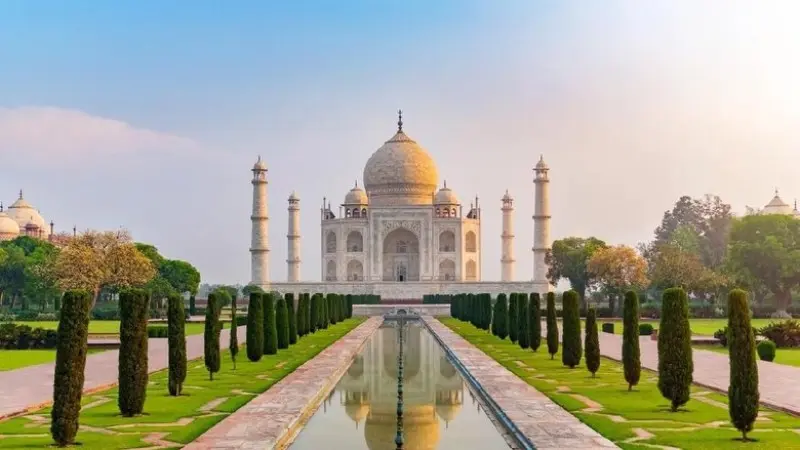The Taj Mahal, located in the city of Agra, India, is an architectural marvel that has captured the hearts and minds of people worldwide. Its breathtaking beauty, profound history, and romantic allure make it one of the most iconic structures on the planet.
This article delves into the captivating history of the Taj Mahal, the reasons why millions of visitors are drawn to its grandeur, the ideal time to visit, and the enchanting features that make it a must-see destination.
History
Commissioned by the Mughal Emperor Shah Jahan in the 17th century, the Taj Mahal was built as a mausoleum for his beloved wife, Mumtaz Mahal. Construction began in 1632 and took over two decades to complete. The emperor employed the most skilled architects, artisans, and craftsmen from India and around the world, resulting in a perfect blend of Persian, Islamic, and Indian architectural styles.
The Taj Mahal’s creation stands as a testament to the enduring love between Shah Jahan and Mumtaz Mahal. The emperor spared no expense in adorning the mausoleum with exquisite details, including intricate marble inlay work, delicate carvings, and ornate calligraphy.
The white marble structure, set amidst lush gardens and reflecting pools, was designated as a UNESCO World Heritage Site in 1983.
Why Visit the Taj Mahal
The Taj Mahal is a symbol of eternal love and devotion, making it an unparalleled destination for romantic souls. Its unparalleled beauty and craftsmanship make it an architectural marvel that has stood the test of time. Visitors are enchanted by its graceful domes, elegant minarets, and the intricate detailing that adorns every inch of its exterior and interior.
Beyond its romantic appeal, the Taj Mahal holds immense historical and cultural significance. It serves as a testament to the grandeur of the Mughal Empire and offers insights into the artistic and architectural achievements of the era.
Moreover, it provides a serene and tranquil atmosphere for introspection and reflection, allowing visitors to appreciate the beauty and craftsmanship of a bygone era.
Location and Route
The Taj Mahal is situated in Agra, a city in the northern state of Uttar Pradesh, India. Agra is well-connected by air, road, and rail, making it easily accessible from major cities in India. The nearest airport is the Agra Airport, which offers domestic flights from select destinations. Alternatively, visitors can also fly into the Indira Gandhi International Airport in New Delhi, which is approximately 200 kilometers away, and then travel to Agra by road or train.
Once in Agra, reaching the Taj Mahal is convenient. The mausoleum is located on the banks of the Yamuna River and can be accessed by a short drive or a leisurely stroll from the city center. Local transportation options, such as auto-rickshaws and taxis, are readily available.
When to Visit
The best time to visit the Taj Mahal is during the cooler months, from October to March, when the weather is pleasant and comfortable. The scorching summers and monsoon rains, which occur from June to September, can make the experience less enjoyable. The Taj Mahal is open every day except Fridays, allowing visitors to plan their trip accordingly.
What to See
Upon entering the Taj Mahal complex, visitors are greeted by the magnificent main gateway, known as the Darwaza-i-Rauza. As they step through the gateway, the ethereal beauty of the Taj Mahal unfolds before their eyes. The main mausoleum stands at the far end of the complex, radiating a sense of serenity and grandeur.
Inside the mausoleum, visitors can pay their respects to Mumtaz Mahal and Shah Jahan, whose tombs are located in a serene chamber at the center. The marble lattice screens, delicately carved with floral motifs, create a mesmerizing play of light and shadow, adding to the mystical ambiance.
Exploring the surrounding gardens is also a must-do experience. The meticulously manicured lawns, fragrant flowerbeds, and reflecting pools offer a tranquil setting to soak in the beauty of the Taj Mahal from different perspectives. The water channels, lined with cypress trees, add to the visual splendor.
Conclusion
The Taj Mahal stands as a testament to the power of love and the enduring beauty of architectural masterpieces. Its rich history, unparalleled beauty, and cultural significance make it a must-visit destination for travelers from around the world. A trip to the Taj Mahal offers a glimpse into the past and allows visitors to appreciate the brilliance of human creativity and craftsmanship.
Whether you are a history enthusiast, a romantic soul, or an admirer of art and architecture, the Taj Mahal promises an unforgettable experience that will leave you awestruck and inspired.
